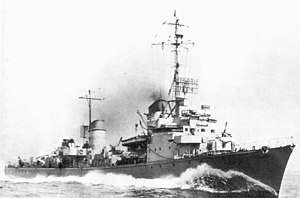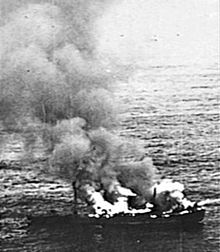German torpedo boat T23
 Sister ship T35 in US service, August 1945
| |
| History | |
|---|---|
| Name | T23 |
| Ordered | 10 November 1939 |
| Builder | Elbing, East Prussia |
| Yard number | 1482 |
| Laid down | 1 August 1940 |
| Launched | 14 June 1941 |
| Completed | 14 June 1942 |
| Fate | Transferred to Britain as war reparations, 1945; then to France, 4 February 1946 |
| Name | L'Alsacien |
| Namesake | The Alsatian |
| Acquired | 4 February 1946 |
| Recommissioned | December 1949 |
| Out of service | 9 June 1954 |
| Renamed | 4 February 1946 |
| Stricken | 17 February 1954 |
| Fate | Sold for scrap, after 9 June 1954 |
| General characteristics (as built) | |
| Class and type | Type 39 torpedo boat |
| Displacement |
|
| Length | 102.5 m (336 ft 3 in) o/a |
| Beam | 10 m (32 ft 10 in) |
| Draft | 3.22 m (10 ft 7 in) |
| Installed power |
|
| Propulsion |
|
| Speed | 33.5 knots (62.0 km/h; 38.6 mph) |
| Range | 2,400 nmi (4,400 km; 2,800 mi) at 19 knots (35 km/h; 22 mph) |
| Complement | 206 |
| Sensors and processing systems | |
| Armament |
|
The German torpedo boat T23 was one of fifteen
After returning to Germany in early 1944, the boat was assigned to support German operations in the
Design and description
The Type 39 torpedo boat was conceived as a general-purpose design, much larger than preceding German torpedo boats.
As built, the Type 39 ships mounted four
Construction and career
Originally ordered as a
Now assigned to the 4th Torpedo Boat Flotilla, T23 returned to the Bay of Biscay to help escort U-boats through the Bay in July. While providing distant cover for a small convoy during the night of 3/4 October, the 4th Flotilla spotted a force of five British destroyers off the Sept-Îles near the coast of Brittany in the Channel and attacked with complete surprise. The first volley of five torpedoes all missed, but the British did not see them and continued on their course. Only when T23 turned on her radar to determine the range for a second volley did they react when one of the British destroyers detected the radar; they altered course just in time for the second volley of torpedoes to miss. Two of the British ships were able to pursue the retreating Germans at high speed, but both were damaged by German gunfire and forced to disengage.[7]
Battle of Sept-Îles
On 22 October, the 4th Flotilla, now consisting of T23, T24, and their sisters
Battle of the Bay of Biscay

On 24–26 December T23 was one of the escorts for the 6,951

The German ships were unaware of the sinking until the following afternoon and continued onward to the rendezvous point. They had been spotted by an American Liberator bomber on the morning of the 28th and the British light cruisers
Subsequent activities
In early February 1944, T23 and T22 returned to Germany via the English Channel and T23 began a refit at Bremen that lasted until June. The boat was then assigned to the 5th Torpedo Boat Flotilla operating in the Baltic. She was attached to the 6th Torpedo Boat Flotilla to help them lay a minefield in Narva Bay, off the Estonian coast, on the night of 17/18 August. The boats, T23, T22 and their sisters T30 and T32 each loaded 54 mines in Helsinki, Finland, and departed on the evening of the 17th. Shortly after midnight, they started to lay their mines, but had only just begun when T30 struck a pair of mines about 00:25 which knocked out all electrical power. About a minute after that, T32 also struck a pair of mines that blew her bow off and disabled her engines. At this T22's crew began making her mines safe and jettisoning them to clear the quarterdeck for towing. At 00:30 T30 exploded and broke in half, probably after hitting another mine. T22's crew finished jettisoning her mines at 00:40 and signaled T32 to see if she was ready to be towed. T32 replied that she was not able to be towed forward, which meant that she would have to be towed stern-first. Around 00:50 T22 began to approach T32 despite being warned that mines were present and struck two of them and blew up at around 01:14. Four minutes later, look-outs reported a motor torpedo boat moving fast aft of the ship and the hydrophones picked up engine noises. Korvettenleutnant Weinlig, thinking that the explosions that sank T22 were torpedoes rather than mines, decided that T23 needed to withdraw lest she be sunk as well, despite the presence of survivors in the water and the crippled T32.[Note 3] He radioed for shallow-draft boats to rescue the survivors at 01:20 and headed west with multiple reports of other ships nearby for the next several hours. At 01:50, T23 encountered the submarine U-679 and Weinlig was preparing to attack before she was recognized as a German submarine. The Soviets never claimed to have sunk any of the torpedo boats that night and the 01:18 spot report was undoubtedly a pinnace from T30 that was pulling survivors from the water.[13]
On 20–21 August, T23 and her sister
Prinz Eugen, two destroyers, T23 and T28 supported a German counterattack against advancing Soviet forces near
Postwar activities
After the war, the boat was allocated to the British when the Allies divided the surviving ships of the Kriegsmarine amongst themselves in late 1945. After protests by France, the
Notes
Citations
- ^ Whitley 1991, p. 52
- ^ Gröner, p. 195
- ^ Sieche, p. 239
- ^ Whitley 1991, pp. 54, 203
- ^ Friedman, p. 205; Whitley 1991, pp. 52–55; Whitley 2000, p. 73
- ^ Rohwer, pp. 215, 241, 249; Whitley, pp. 144, 211–212
- ^ Rohwer, p. 279; Whitley, pp. 145, 147
- ^ Rohwer, p. 282; Whitley, pp. 147–148
- ^ Rohwer, pp. 294–295; Whitley, p. 149
- ^ Hervieux, p. 98
- ^ Hervieux, p. 98; Rohwer, p. 295; Whitley 1991, pp. 149–153
- ^ Whitley 1991, p. 179
- ^ Gröner, p. 195; Hervieux, p. 101; Rohwer, p. 338; Whitley 1991, pp. 156, 175–179, 211
- ^ Rohwer, pp. 351, 359, 361, 373, 377; Whitley 1991, pp. 180–186, 212
- ^ Hervieux, pp. 101–102; Rohwer, pp. 387, 398, 414; Whitley 1991, pp. 187, 189, 191
- ^ Whitley, pp. 199, 212
- ^ Roche, p. 33
- ^ Jordan & Moulin, p. 284
References
- ISBN 0-85177-238-2.
- ISBN 0-87021-790-9.
- Hervieux, Pierre (1986). "The Elbing Class Torpedo Boats at War". In Lambert, Andrew (ed.). Warship X. London: Conway Maritime Press. pp. 95–102. ISBN 0-85177-449-0.
- Jordan, John & Moulin, Jean (2015). French Destroyers: Torpilleurs d'Escadre & Contre-Torpilleurs 1922–1956. Barnsley, UK: Seaforth Publishing. ISBN 978-1-84832-198-4.
- Roche, Jean-Michel (2005). Dictionnaire des bâtiments de la Flotte de guerre française de Colbert à nos jours. Vol. II: 1879–2006. Toulon, France: J.-M. Roche. ISBN 2952591717.
- ISBN 1-59114-119-2.
- Sieche, Erwin (1980). "Germany". In Chesneau, Roger (ed.). Conway's All the World's Fighting Ships 1922–1946. London: Conway Maritime Press. ISBN 0-85177-146-7.
- ISBN 1-85409-521-8.
- Whitley, M. J. (1991). German Destroyers of World War Two. Annapolis, Maryland: Naval Institute Press. ISBN 1-55750-302-8.
Further reading
- Whitby, Michael (2022). "The Challenges of Operation 'Tunnel', September 1943 — April 1944". In Jordan, John (ed.). Warship 2022. Oxford: Osprey Publishing. pp. 29–46. ISBN 978-1-4728-4781-2.
